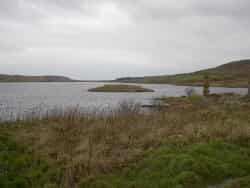 |
|||
Finlaggan and the Lordship
|
 |
Links to pages in the Place Guide
|
|
Links to pages in the Place Guide |
|||||||||||||||||||
| Finlaggan and the Lordship Something you just have to do on an Islay visit. All these pictures can be clicked on for the full-sized image. It was a dirty, cold and windy day just after Hogmanay when Wolfgang JJ and I stopped to look round Finlaggan. Finlaggan bodes with a weight of history that certainly predates Christianity but what it is probably best known for is the site of the lordship. For centuries the west coast of Scotland was ruled from here by the Macdonalds – the Lords of the Isles. The first picture shows the end of Loch Finlaggan – you can almost feel the bitter east wind drying the turf. In the summer on one of the rare hot sunny days I will go by and get some more erm … warm pictures. The island is connected with a wooden causeway so there is no problem getting there. There is a nice visitor centre there by the way but it is only open on certain days and at certain times – check in the information centre in Bowmore for definite times. Islay has been settled since at least 7000 B.C. by nomadic mesolithic hunters, and has been permanently settled by neolithic farmers since around 3500 B.C. There is evidence of settlement continuously since that time leading up to our Norse forbears being ousted by the Viking Somerled around 1156. There is wealth of tradition around the establishment of the Lordship, the small book by Norman Newton "Islay" ISBN 0 7153 8996 3 covers it well. From Somerled came the famous Angus Og and Donald from whom the name Macdonald came. It is a legend that all Macdonalds in the world claim descent from that one man, grandson of Somerled but this is probably not true. The Lordship extended until 1493 and at its height governed virtually the whole of the west coast of Scotland. The centre of this was the island on Finlaggan Loch. The Finlaggan Trust have developed this and much archeological work has been done there including work by the famous TV "Time Team". The site consists of two islands, the larger romantically called Eilean Mòr (big island) and the smaller island, where the councils of the Lordship were held in the council house, is called Eilean na Comhairle (council island – OK we are just pragmatic about what we call things). What we can see now is some of the ruins of the building on the two islands. In the ruined chapel there are some fantastic grave slabs, the best perhaps of a man in armour from around 1550. On the mainland side of the islands there is a mound of some significance which extends a line through a standing stone and on to the Paps of Jura. The Time Team investigated this and found that the single visible stone was one of a group or aisle of stones that pointed to the Paps, perhaps of religious or ceremonial significance. A video of the Time Team investigation is in the Visitor Centre. Also there is good evidence that mining was going on at Finlaggan around 1000 a.d. There are two good sites, the ENVI page and the University of Edinburgh Archaeology department |
||
Links Sons of Somerled Album by Steve Macdonald pictures on this page by JJ and Wolfgang |
 Eilean na Comhairle from Eilean Mòr |
|